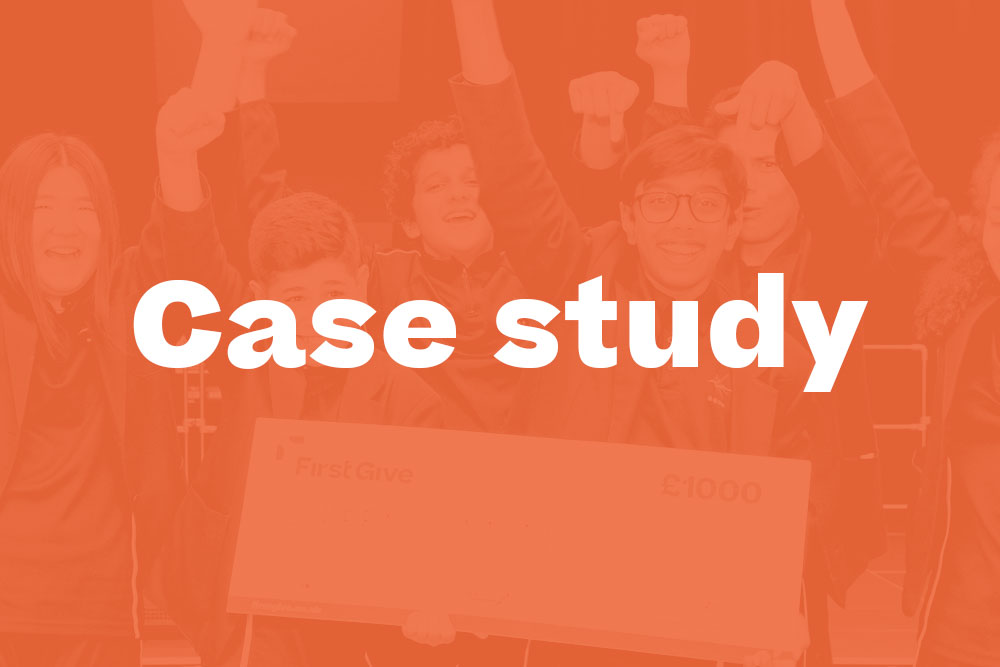Building Understanding: Students lead workshops that advocate for the visually impaired
Bronte Girls Academy students increased their empathy and compassion through social action.

At First Give, we are dedicated to empowering young people as they make a positive difference in their communities through charitable social action.
Through our core programme, a whole year group of students engages in a dynamic experience where they identify social issues that they care about, connect with local charities and develop and deliver social action projects for those charities. In the latter half of the programme, students develop engaging and creative presentations that they’ll showcase at their school’s First Give Final – an exciting celebration at the end of their programme where the year group compete in their classes to secure a £1,000 First Give grant on behalf of their class charity.

Students across England and Wales that engage in the First Give core programme are asked to think about how they can give their time, money and skills to causes that they care about. Year 7 students at Bronte Girls Academy really embraced this challenge, curating a host of thoughtful awareness raising activities for their peers to engage in, in support of the local charity Guide Dogs, supporting those living with sight loss in the Bradford community. Susie Finlinson, National Schools and Youth Campaign Manager for the charity, notes that “The impact of sight loss can be devastating, made worse by a lack of understanding in our society. More than half of people with significant sight loss say they’ve experienced negative attitudes or discrimination as a result.”

Inspired by this, the students set about planning a series of engaging workshops for their peers to take part in that would develop students’ empathy and understanding when it comes to the obstacles faced by those living with sight loss. This included:
- What’s in the box – an activity that forced participants to rely on touch to work out what was inside the box
- Shoot the hoop – a basketball challenge with a twist! Participants had to try and shoot a hoop while wearing goggles that simulated different visual impairments
- Pin the nose on the guide dog – A blindfolded activity and new spin on the familiar childhood party game ‘pin the tail on the donkey’
- Drawing challenge – asking students to explain to somebody else what they needed to draw without using visual aids
- Obstacle course – a paired activity where one student verbally guided the other, who was blindfolded, around a series of obstacles such as climbing over benches and walking through hoops

The students were keen to ensure that their activities were varied, allowing as many people as possible to engage with them. It was great to see how they incorporated activities such as sport and drawing – activities the young people themselves partake in at least weekly – and showed participants how visual impairment could impact their every day, allowing them time to stop and think. Their teacher, Ms Fearnley, added:
Both my students and I learned a lot from this programme… We worked together as a team to achieve our goal. They have gained not only knowledge but cultural capital through speaking to people from the charity and with visual impairment, meeting guide dogs and putting on an event they planned and delivered.
The students’ work created such a buzz that staff were also keen to get involved, and there was talk of the students delivering sessions to teachers as part of their CPD – an excellent idea that really demonstrates the school’s engagement with the programme, and further highlights the power and impact of the students’ efforts.
What led to this group winning the First Give grant was the level of care that they put into their social action activities, further demonstrated at their First Give Final, where the students even gave the judges an opportunity to experience what it means to be visually impaired, offering visual impairment simulation goggles for judges to wear throughout the presentation, asking them to reflect on how this feels, and inviting them to consider what it would mean to live with visual impairment every day. Susie from the charity further added:
we were incredibly pleased to be given this opportunity to work with the young people at Bronte Girls Academy, who have really demonstrated to us that they are beacons of change in their community… Their ideas were inspiring, and went a long way to building empathy across the school community. We want to say a huge thank you to the Bronte Girls Academy, not only for winning the vital funds we need, but for helping us spread our key messages in a way that really represented our values of being person-centered, optimistic and collaborative.
